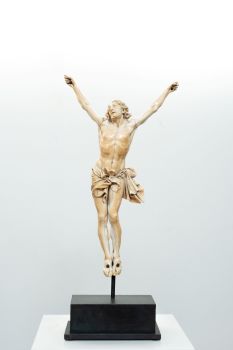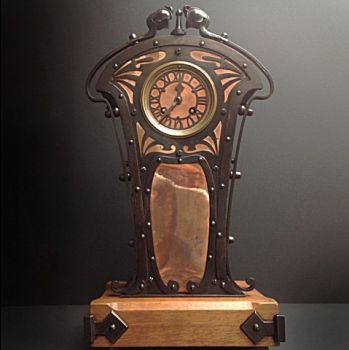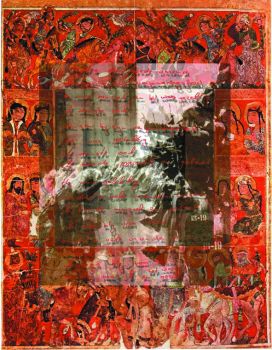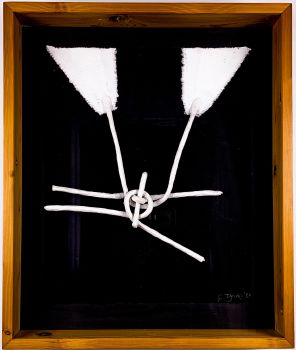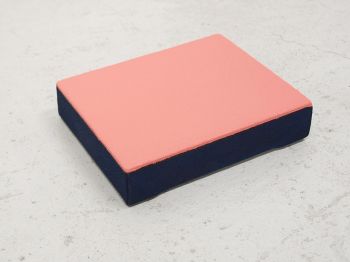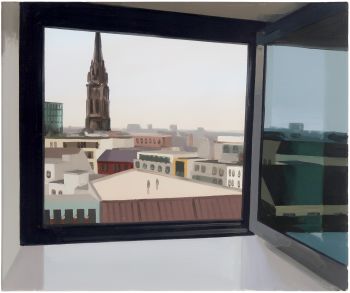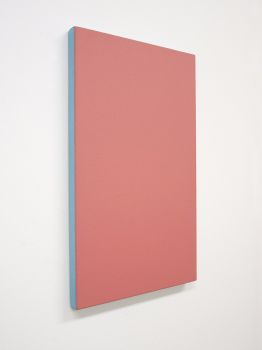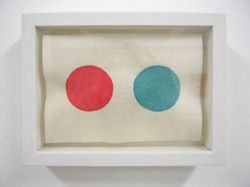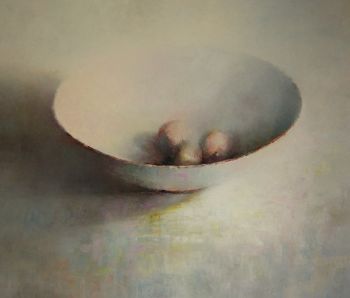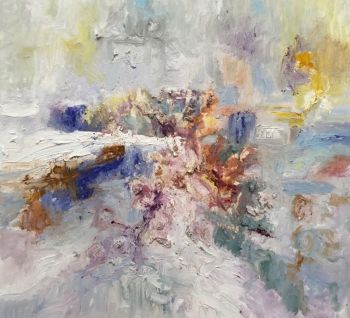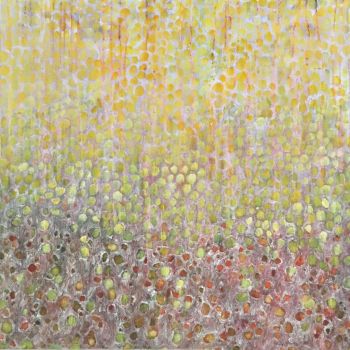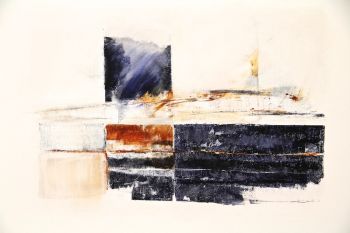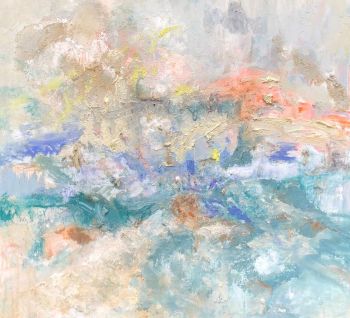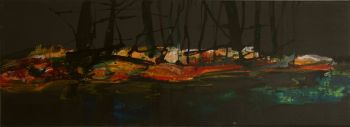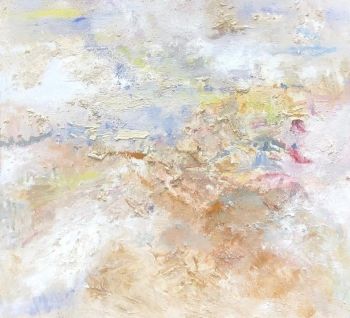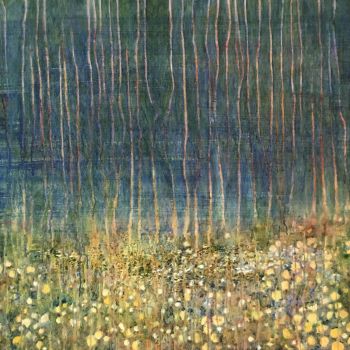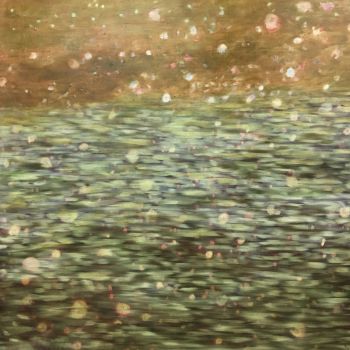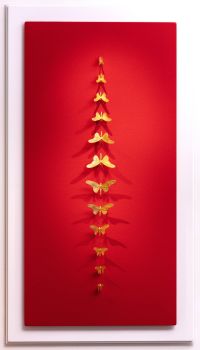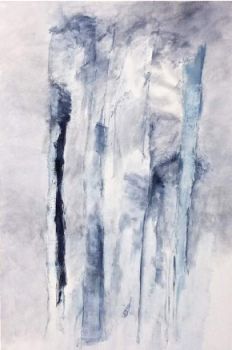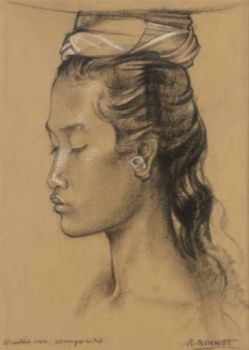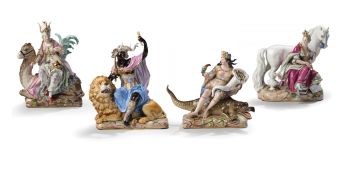A very rare Indian Armorial Palempore Chintz for the Dutch Market 1750
Artista Desconocido
TextilAlgodón
333 ⨯ 225 cm
Precio a consultar
Zebregs & Röell - Fine Art - Antiques
- Sobre la obra de arteCoromandel coast, probably Sadraspatnam (Sadras), first half 18th century
Cotton, mordant- and resist-dyed, painted, 333 x 225 cm
“Palempore” refers to large chintzes laid on a bed or hung behind it. The present very large palempore in the centre shows a coat of arms with a redish salient deer in front of a green tree on the ground, the crest with a deer issuant. The mantling shows scrolling leaves and European style scrollwork in red and green, within a circle of flowers. In the corners of the white field four vases with large flower bouquets. The borders are decorated with undulating vines with flowers and leaves issuing from large flowers and leaves in each corner and in the middle of the long sides.
The coat of arms probably belongs to Jacob Hartogh (Leiden, 30 October 1701 - Delft after 1756), a cloth manufacturer in Leiden. His father, Hendrik Hartogh, a cloth-shearer, emigrated from Bremen to Leiden at the end of the 17th century. He married Jannetje Pieters in 1701 and the couple had two sons, Jacob and Jan. Jacob, from 1740 till 1756, owned a cloth factory at the Turfmarkt in Leiden. In 1756 he sold the factory and settled in Delft. Jacob married twice, first to Katharina Paré (1697-?) in 1721, and secondly some time before 1735 to Marianne Petit (1708-?). His son from the first marriage, Michiel Hartogh, also became a cloth manufacturer in Leiden and his descendants held public posts in Delft and Rotterdam during the second half of the 18th century.
Jacob possibly ordered the palempore somewhere shortly before 1735. Jacob presumably also ordered an armorial chine de commande tea set, dated between 1730 and 1735, of which only some cups and saucers survive. The coat of arms on the tea set consists of a tree on the ground with a yellow tripping deer in front, the crest with a yellow deer issuant, and the mantling with polychrome scrolling leaves (Dr. Jochem Kroes, Chinese Armorial Porcelain for the Dutch Market, Waanders Publishers, Zwolle 2007, pg. 168).
Several other similar armorial chintzes all bear the arms of Frisian and Groninger families; Goslinga (Rijksmuseum, inv. BK-1980-795), Burmania (Rijksmuseum, inv. BK-1980-98), Alberda-Horenken-van Berum, Rengers van Welderen, and Douma van Langweer (Ebeltje Hartkamp-Jonxis, Sitsen uit India Indian Chintzes, Rijksmuseum Amsterdam 1994). Ebeltje Hartkamp-Jonxis dates these armorial chintzes to a short period between 1725 and 1730. The present palempore appears to be the only one of this design, probably ordered by a family from the province of Holland. Armorial palempores with different designs are known from Holland and Zeeland. - Sobre el artista
Puede suceder que un artista o creador sea desconocido.
Algunas obras no deben determinarse por quién está hecho o por (un grupo de) artesanos. Algunos ejemplos son estatuas de la Antigüedad, muebles, espejos o firmas que no son claras o legibles, pero también algunas obras no están firmadas en absoluto.
También puedes encontrar la siguiente descripción:
•"Atribuido a …." En su opinión, probablemente una obra del artista, al menos en parte.
•“Estudio de….” o “Taller de” En su opinión, una obra ejecutada en el estudio o taller del artista, posiblemente bajo su supervisión
•“Círculo de…” En su opinión, una obra del período del artista que muestra su influencia, estrechamente asociado con el artista pero no necesariamente su alumno.
•"Estilo de …." o “Seguidor de…”. En su opinión, una obra ejecutada al estilo del artista pero no necesariamente por un alumno; puede ser contemporáneo o casi contemporáneo
•"Manera de …." En su opinión una obra al estilo del artista pero de fecha posterior
•"Después …." En su opinión, una copia (de cualquier fecha) de una obra del artista
•“Firmado…”, “Fechado…” o “Inscrito” En su opinión, la obra ha sido firmada/fechada/inscrita por el artista. La adición de un signo de interrogación indica un elemento de duda.
•“Con firma…”, “Con fecha…”, “Con inscripción…” o “Lleva firma/fecha/inscripción” en su opinión la firma/fecha/inscripción ha sido añadida por alguien que no es el artista
¿Está interesado en comprar esta obra de arte?
Artwork details
Related artworks
- 1 - 4 / 12
Artista Desconocido
Japanese transition-style lacquer coffer 1640 - 1650
Precio a consultarZebregs & Röell - Fine Art - Antiques
Artista Desconocido
IMPORTANTE Y RARO PINTURA INDIA DE ESTILO DE COMPAÑÍA EN MARFIL QUE REPRESENTA UN DESFILE1850 - 1900
Precio a consultarZebregs & Röell - Fine Art - Antiques
 curada por
curada porDanny Bree
Thea G.F. Eschauzier
Retrato de una niña javanesa1931
Precio a consultarZebregs & Röell - Fine Art - Antiques
Paulus Franciscus Kromjong
Flores frente a Arearea Aka (alegría) por Gauguin '20th century
Precio a consultarZebregs & Röell - Fine Art - Antiques
Artista Desconocido
UN INUSUAL PLATO DE PLATA CON LOBBED INDONESIOlate 17th
Precio a consultarZebregs & Röell - Fine Art - Antiques
Artista Desconocido
A Surinam-themed Amsterdam long-case clock1746 - 1756
Precio a consultarZebregs & Röell - Fine Art - Antiques
 curada por
curada porGallerease Magazine
Artista Desconocido
A silver spoon commemorating Juff’ Margareta van Hoorn1656 - 1694
Precio a consultarZebregs & Röell - Fine Art - Antiques
1 - 4 / 23 curada por
curada porDanny Bree
Artista Desconocido
UN RARO TELESCOPIO DE CUERO LACADO JAPONÉS GRANDE1750 - 1800
Precio a consultarZebregs & Röell - Fine Art - Antiques
1 - 4 / 24Artista Desconocido
Japanese transition-style lacquer coffer 1640 - 1650
Precio a consultarZebregs & Röell - Fine Art - Antiques
Artista Desconocido
Holandeses en miniatura (Netsuke)1700 - 1900
Precio a consultarZebregs & Röell - Fine Art - Antiques
Artista Desconocido
A silver spoon commemorating Juff’ Margareta van Hoorn1656 - 1694
Precio a consultarZebregs & Röell - Fine Art - Antiques
Artista Desconocido
The bell of the VOC fortress in Jaffna, Sri Lanka1747
Precio a consultarZebregs & Röell - Fine Art - Antiques
 curada por
curada porDanny Bree
Artista Desconocido
UNA COLECCIÓN DE CUATRO CAJAS BÍBLICAS DE MARFIL DE SRI LANKAN18th century
Precio a consultarZebregs & Röell - Fine Art - Antiques
1 - 4 / 24- 1 - 4 / 24
Dutch School
Llegada de un holandés de las Indias Orientales a Table Bay18th century
Precio a consultarZebregs & Röell - Fine Art - Antiques
Artista Desconocido
The bell of the VOC fortress in Jaffna, Sri Lanka1747
Precio a consultarZebregs & Röell - Fine Art - Antiques
 curada por
curada porDanny Bree
1 - 4 / 12




